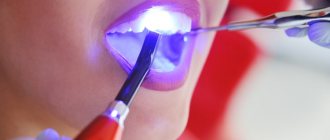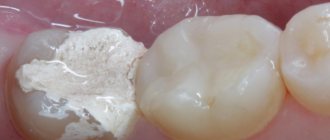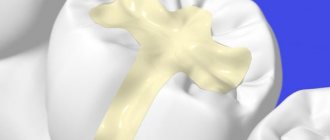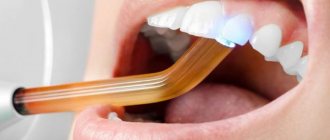Sometimes, after dental treatment, patients go to the dental clinic with a complaint of pain, not knowing that pain after some dental procedures is a normal phenomenon, and only in rare cases does it serve as a warning sign.
What causes pain after dental treatment and what to do in this situation?
If the filling interferes after treatment
Even in the doctor’s office, after installing the filling, be sure to make sure that the restored tooth is not in the way (move your jaw back and forth, sideways, carefully close your teeth). The filling should not be felt or change the bite. Don’t be shy about talking to your doctor about any discomfort—sometimes the final stage of filling treatment can take even longer than removing cavities and applying filling material.
After treatment, anesthesia wears off within 1.5-2 hours. If a conductor type was used, then after 4-6 hours. Now you are beginning to fully feel the treated tooth, you can fully close your jaws and understand how comfortable you are after filling.
If you experience slight discomfort, it feels like the tooth is a little larger and your jaws aren't closing quite tightly—this is normal. The fact is that now you have been given a new filling in accordance with the bite, that is, with the shape and position of the tooth located on the opposite side. The treated tooth became taller than before - after all, there was caries and the old filling sagged. Therefore, if there is no sharp pain and obvious rejection, be patient for a few days. If the situation normalizes and you get used to it, then there is no reason to see a doctor. If discomfort persists for 1-2 weeks, you should visit your dentist to have the filling corrected.
Complications after removal
In some cases, tooth extraction can cause complications. They can be associated both with poor quality of the procedure itself and with illiterate oral care during the healing period.
The main complications that may arise during tooth extraction include the following:
- an abscess that appears as a result of infection in open wounds in the sockets where teeth used to be;
- bleeding, which may be a consequence of injury to the gums during the healing period, and may also occur due to the presence of hypertension or poor blood clotting in the patient;
- paresthesia, characterized by numbness of the gums or part of the jaw in the place where the tooth was pulled out.
One of the most serious complications is osteomyelitis. It is characterized by the presence of an inflammatory process in the bone and bone marrow. This disease can occur when the patient has an infection of the bone tissue against the background of a general decrease in immunity. This disease requires immediate treatment.
Symptoms
The main symptom of a complication after tooth extraction is increased pain after the 5th day of healing. If by this period they do not subside, then you need to contact a specialist to find out the reasons. This could be either inflammatory processes or the presence of tooth particles that went unnoticed after the procedure.
Another symptom is a strong increase in temperature, sharp cramps in the head that last more than 5 days. This can also cause your gums to swell. If this happens, it means that the swelling cannot go away for some reason. This, in turn, is a sure sign of a complication.
Reasons for the development of complications
There can be a large number of reasons for the appearance of one or another complication. In addition to medical errors and improper oral care, these include the presence of certain physical diseases in the patient, which can lead to the development of inflammation or frequent bleeding.
To prevent such situations from arising, the patient must warn the doctor about all his ailments, even if he is sure that they will not affect the outcome of the procedure. After this, the specialist will be able to select certain medications that will reduce the risk of complications and make the wound healing process more comfortable.
How long should you not eat after having a filling installed?
If a filling made of chemical composites is installed, then you should refrain from eating and drinking for 2 hours. This is due to the fact that the material requires a certain time for final shrinkage and hardening.
If a “light” composite filling is installed, you can drink immediately, but you should abstain from food for 1.5-2 hours. But the reason is not in the material (it hardens a few seconds after application), but in anesthesia - with reduced sensitivity of the mucous membranes during eating, you can injure the tongue and mucous membranes of the cheeks on the inside.
During the day after the filling is installed, you should only eat warm foods - excessively hot or cold foods can lead to changes in the shape of the filling. It is necessary to chew food on the opposite side for the first day - this will allow the material to fully “adhere” to the tissues and take the desired shape, without the risk of damage.
Why does a tooth hurt after a filling is installed?
Minor soreness may persist for several days or even a couple of weeks, which is explained by overheating of the tissue due to the use of boron. In some situations, for example, with deep caries or when treating front teeth, increased sensitivity can persist even for several months. But in such a situation, you should still consult a doctor for an x-ray to make sure that there is no infected tissue left under the filling and that inflammation has not affected the nerve.
If the pain intensifies, the filling darkens, black spots appear under it - all this indicates that the treatment was carried out poorly and re-inflammation has begun. This is a reason to see a doctor as soon as possible.
When is tooth canal cleaning performed?
It is necessary to treat and fill root canals in the following cases:
- If caries has progressed to pulpitis (infection has spread to the dental pulp, or colloquially “dental nerve”). The pulp will have to be removed (the tooth depulped), and the root canals in which it was located will have to be thoroughly cleaned of tissue debris and sealed.
- If it is necessary to prepare a dental unit for the installation of a crown and the doctor believes that depulpation is necessary. Previously, when installing single crowns or supporting crowns of a bridge, the teeth were necessarily subject to depulpation; now this procedure is not performed in all situations and only when installing certain types of dentures.
- If there is a need for re-treatment of the tooth after the occurrence of a secondary source of infection or with the development of periodontitis, inflammation of the tissues around the tooth root (develops with poor-quality canal filling).
In all these situations, endodontic treatment is carried out (the name comes from the Latin words “inside” and “tooth”, that is, it can be literally translated as intradental treatment) with mandatory filling of the dental canals.
If you have a problem similar to that described in this article, be sure to contact our specialists. Don't diagnose yourself!
Why you should call us now:
- We will answer all your questions in 3 minutes
- Free consultation
- The average work experience of doctors is 12 years
- Convenient location of clinics
Single contact phone number: +7
Make an appointment
What to do if your gums hurt after filling
The gums in the area where the anesthesia was administered may ache for several days - this is completely normal and does not require any measures. The mucous membrane may also be slightly inflamed if special rings were used during treatment, which are placed on the tooth to form the correct shape of its crown. The gums can also be damaged if the doctor had to install the filling material in close proximity to the mucous membrane or even under it - in such a situation the gums are deliberately pushed back. Therefore, pain is a normal reaction to external intervention.
All of these conditions are variations of the norm. But if the pain intensifies, redness and swelling of the mucous membrane progresses, you need to consult a doctor.
What to do after removal?
After tooth extraction, it is important to maintain proper oral hygiene and also slightly limit your diet. The main recommendations are:
- You can apply a cold compress to the damaged gum, which will reduce the pain;
- if the bleeding does not decrease, you can firmly press a cotton swab between the teeth in the area of tooth extraction;
- For disinfection, rinses based on natural herbs should be used;
- It is better to eat only warm and soft foods without solid particles.
Medications can also be used to reduce discomfort. However, you can only use those medications prescribed by your doctor. He should also tell you how long to rinse so as not to damage the wound.
If at any stage of healing the patient feels an increase in pain symptoms or discomfort that is not normal, he should immediately inform the doctor.
How to properly perform hygiene procedures
After treatment, brush the filled tooth carefully, applying minimal pressure to it. Do not use rinses containing abrasive substances and alcohol, which can increase the plasticity of the material - this will lead to a change in the shape of the filling. Also, do not use excessively hard brushes - they can leave microcracks in the material, which will quickly damage it.
In general, you should take care of teeth with fillings in a completely standard way:
- daily brushing of teeth twice a day - in the morning before breakfast and in the evening after all meals, after - rinsing the mouth with water and rinse,
- To clean the area of filled teeth after eating, it is better to replace dental floss with an irrigator. If you floss carelessly, you can touch the installed filling, especially if there are thin edges of the tooth, which will lead to its loss.
Why is tooth extraction required?
In certain cases, tooth extraction is the only possible method of solving a particular dental problem. Indications for removal may include:
- Incorrect position of the tooth, when neither the patient nor the doctor can access it (high-quality hygiene and/or treatment is impossible);
- The absence of the main part of the dental material without a chance of its restoration;
- Malocclusions (for example, severe crowding);
- Inflammatory process in the roots of the tooth, which can lead to infection;
- Painful eruption of wisdom teeth.
This is also necessary when preparing to correct your bite using Invisalign aligners. In particular, it is usually necessary to remove the “eights” if they have not fully erupted and can interfere with quality orthodontic treatment. It is worth noting that such a decision should be prepared when there are certain indications and no other option is possible.
Otherwise, when installing aligners, the unerupted tooth hidden inside the gum will prevent the aligner from attaching and pull the remaining teeth in the right direction, leaving them no room to move.
Is it necessary to follow a diet after caries treatment?
From the diet as a whole after caries treatment (especially if a large filling is installed and your own tooth has very thin walls), it is recommended to remove too hard foods - toffees, chewing gum, grilled fruit, nuts, etc. Or chew them with teeth located on the opposite side (if they do not have fillings).
Minimize the amount of consumed foods and drinks that contain coloring pigments (tea, coffee, beets) - under their influence, the filling material may slightly change its shade. This rule is especially relevant when restoring front teeth.
Why do patients experience pain after caries removal?
The Nurimed Clinic provides highly qualified treatment for dental caries, but even our specialists cannot promise the absence of pain after therapy, since much depends on the individual characteristics of each patient.
The main factors contributing to the occurrence of pain syndrome:
- Excessive drying of the tooth before placing a filling. Before completing caries treatment, the doctor etches the enamel with a special compound, which is then washed off and the dentin is dried. When the tissue is overexposed, its natural moisture is lost, which subsequently leads to pain.
- Insufficient tooth drying. Remaining moisture on the dentin leads to the fact that the filling is not fully and correctly attached. In such situations, it is very likely to be torn off, and the tooth will be disturbed under vertical loads (chewing).
- Relapse of the carious process. Caries is an infectious disease caused by pathogenic flora. Doctors are not always able to completely get rid of bacterial pathogens, which is why pain appears again some time after treatment.
- Complications after caries. Even after treatment, it cannot be guaranteed that the carious process has not reached the pulp or periodontium. The pain process can be triggered by an exacerbation of the inflammatory process in these areas.
- Incomplete removal of the neurovascular bundle (pulp). Even X-ray studies can give false information, so remnants of nerve endings cannot always be removed immediately. This is especially true for people with branchy and deep roots.
- Exit of the filling into the periapical area. A rare complication, since all procedures in modern dentistry are performed under radiographic control.
- Presence of air in the filling. The nerve endings are irritated, which causes pain. The problem arises when the filling installation technique is violated.
- Breakdown of instruments. In some cases, in patients with branched and deep roots, instruments break when extracting the pulp. If the debris has not been removed, then an inflammatory process gradually develops, which is accompanied by pain.
- Intolerance to the components of the filling or any other substances used in treatment. The pain syndrome in such cases is caused by severe swelling.
In addition to these common causes, pain can be caused by errors in treatment, in particular, irritation of the pulp by a specific acid used to etch the enamel.
Only a dentist can accurately answer the question of why pain occurs after caries treatment, so you should not put off visiting him.
How to maintain your treatment guarantee
As a rule, therapeutic treatment, that is, dental filling, is guaranteed from 6 months to 2 years - depending on the volume of work and the complexity of the situation. To maintain the guarantee, the patient must strictly follow all recommendations: do not overload the tooth, do not use it for other purposes (for example, open beer bottles), and also regularly see the doctor in accordance with the individual schedule of medical examinations. Unfortunately, many patients forget about this, and it is the last point that is the key to maintaining the guarantee for treatment.
You need to visit a doctor 1-2 times a year. During a preventive examination, the dentist will be able to make sure that the filling is in good condition and that caries does not develop again underneath it.
How to cope with pain?
In the fight against pain, it is not recommended to use untested folk remedies, especially if alarming symptoms develop. If you are not sure whether your feelings are normal, make an appointment with your dentist or consult with him by telephone.
To eliminate pain, special medications prescribed by the doctor are suitable. These most often include drugs from the group of non-steroidal anti-inflammatory drugs, for example, Ibuprofen, Nise, Nimesulide and others.
The medications are taken strictly according to the instructions and recommendations of the dentist. Additionally, cold compresses can be used.











